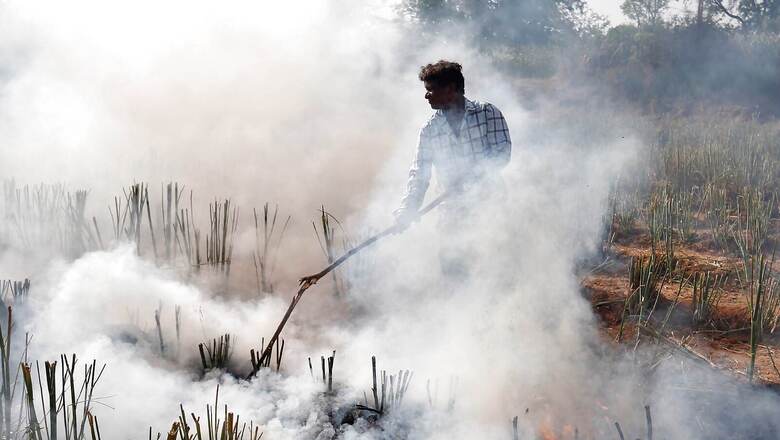
views
With the onset of winter, farm fires become rampant in northern Indian states, particularly in Punjab, Haryana and western Uttar Pradesh. The problem of burning crops is one of the major reasons for deteriorating air quality in the region during winter and contributes to the alarming pollution levels in the neighboring Delhi.
The perennial problem is not only the cause of trouble for the people in Delhi, but over the years it has also became a political issue as heads of state engage in war of words over the yearly problem.
Why Farmers Burn Their Crops?
Wheat and Paddy are the most prevalent crops in the agricultural states, such as Punjab and Haryana. One of the reasons for the stubble burning is attributed to the short time available between rice harvesting and sowing of wheat.
The 2009 Punjab Preservation of Subsoil Act mandates that paddy transplantation date is fixed for June 20 which pushes ahead the harvesting of rice crop, instead of May, so that a significant portion of water is sourced from the rains in the monsoon. However, it leaves farmers with just 20-25 days between two crops. A delay in sowing the wheat would adversely affects the wheat crop. Therefore, the quickest and easiest solution is to burn the crop residue.
Reports suggest that 20 million tonnes of rice stubble are produced every year in Punjab, out of which 80% is burnt on the farm.
Policy Issues?
The National Green Tribunal (NGT) had banned crop residue burning in the states of Rajasthan, Uttar Pradesh, Haryana and Punjab in 2015. Burning crop residue is also a crime under Section 188 of the IPC and under the Air and Pollution Control Act of 1981. However, government’s implementation and check to curb stubble burning lacks strength.
The national programme on crop diversification, which could have allowed for plantation of different crops other than paddy, does not have clear provisions on outreach activities to inform farmers about alternate crop options.
The Supreme Court also stepped in the issue and in 2019 ordered some northern states to give Rs 2,400 per acre to every farmer who didn’t burn stubble. However, the initiative didn’t become a hit as states didn’t pay the farmers.
The Punjab and Haryana also started penalising farmers last year for indulging in stubble burning. But, despite imposition of heavy fines, stubble burning cases continued unabated. But experts say that governments fear taking strong measures fearing that the policy might irk farmers, who are seen as votebanks.
Lack of Inter-communication?
Last month, the Aam Aadmi Party (AAP) which has its government in Delhi, accused the Bharatiya Janata Party (BJP)-led government in Uttar Pradesh and Haryana and Congress-led governments in Punjab and Rajasthan of failing to control stubble burning.
This isn’t the first time that the inter-state problem has become a political issue. In the past couple of years too, the Delhi government have blamed the Punjab and Haryana government for the stubble burning.
This year, Punjab government in September announced it would appoint 8,500 nodal officers for the current paddy growing villages, identified as hotspots, where paddy stubble was being traditionally put on fire. It said that the directions have already been issued to the Deputy Commissioners concerned to give special attention to the hotspot villages.
Haryana CM Manohar Lal Khattar said that no stubble burning is being done in Haryana. “We have given an incentive of Rs 1000 per acre to farmers on selling paddy stubble,” he told reporters in Delhi.
Alternatives
Over the years, there have been many alternatives being explored to curb the menace. The Delhi government has been pressing for adoption of Pusa bio-decomposer, a microbial solution that can reportedly turn stubble into manure, urging the Centre to ask neighbouring states to distribute it for free among farmers. Gopal Rai, Delhi environment minister said that the state government will start spraying Pusa bio-decomposer from 5 October to prevent stubble burning.
He added that the central government is yet to give time for a meeting on the decomposer and other pollution-related issues.
Another method of clearing agricultural fields is using a Turbo Happy Seeder (THS) machine, which can uproot the stubble and also sow seeds in the area cleared. The residual stubble can then be used as mulch for the field.
Officials have also come up with solutions by giving subsidies on resources used to cultivate stubble, for example, the happy seeder tractor or straw baler, which makes compact bales out of stubble and straws. However, such resources coming into mainstream agricultural practice will take their own time due to a lack of capital and awareness in farmers.
Read all the Latest News , Breaking News and IPL 2022 Live Updates here.



















Comments
0 comment